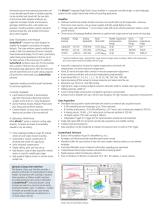 Website:
SUTTER INSTRUMENT
Website:
SUTTER INSTRUMENT
Catalog excerpts

NEW: THE FIRST ALL-IN-ONE SOLUTION FOR PERFORMING DYNAMIC CLAMP EXPERIMENTS FULLY INTEGRATED SINGLE- OR DUAL- HEADSTAGE PATCH CLAMP AMPLIFIER AND DATA ACQUISITION SYSTEM ENSURES QUICK AND EASY SETUP ULTRA-HIGH BANDWIDTH ENABLES CHARACTERIZATION OF THE FASTEST SIGNALS OPTIMIZED FOR LOW-NOISE SINGLE-CHANNEL WHOLE-CELL PATCH CLAMP FULL COMPUTER CONTROL PROVIDES AUTOMATED COMPENSATION OF ELECTRODE AND WHOLE-CELL CAPACITANCE FOR UTMOST PRECISION AND SIGNAL FIDELITY VOLTAGE AND FASTFOLLOWER™ CURRENT CLAMP CAPABILITY FOR COMPLETE CHARACTERIZATION OF CELLS' ELECTRICAL ACTIVITY d P A T C H L O W - N O I S E U LT R A - FA S T D I G I TA L PATC H C L A M P A M P L I F I E R S Y S T E M The dPatch® Digital Patch Clamp Amplifier System is the latest cutting-edge tool for electrophysiology research.. Using high-speed digital processing, matched with high-resolution data converters and paired with SutterPatch® software’s intuitive user interface, this low-noise, high-bandwidth precision instrument provides capabilities previously unattainable to electrophysiologists. Available in either a single- or dual-headstage configuration, the dPatch amplifier’s architecture makes swapping headstages, or adding a second one to a single-headstage version, a plug-and-play operation. The two headstages are independently configurable for either voltage clamp or FastFollower™ current clamp. Data is streamed from each headstage in parallel and fully synchronized. 5 MHz sampling rate, up to 22 bits of resolution One unique feature with dPatch is the headstagebased data sampling system. The signal from each headstage is continually digitized at 5 MHz. Output filtering has thirteen settings between 100 Hz and 1 MHz. A resolution of 18 bits is achieved at 1 MHz. For lower filter settings, automatic downsampling increases resolution while optimizing data rates. At a bandwidth setting of 1 kHz the dPatch system provides a signal resolution of better than 22 bits. Optimal noise performance in both the capacitive and resistive feedback ranges When other products remove thermal energy from the headstage circuitry, it in turn heats up the headstage housing. That leads to thermal drift of the pipette and other, cumbersome side effects. One of the development goals of the dPatch headstage was achieving a comparable noise performance at room temperature, without the need for a cooled headstage. In the two resistive feedback modes, the dPatch amplifier is even quieter than any of the competitor systems. Built-in data acquisition system means no third-party hardware Using a multiplexer-free design, the dPatch provides 8 fully differential analog input channels, 4 analog output channels, and 16 digital outputs (TTL). All I/O channels are sampled continuously (200 kHz for analog inputs, 250 kHz for analog and digital outputs) and available through the user interface. SutterPatch® Software The dPatch amplifier, in combination with SutterPatch software, has been engineered to automatically capture and store all amplifier settings, stimulus information and external experiment parameters, and associate them in time with the raw data traces. This includes all amplifier and acquisition settings, as well as timing and progress of the experiment. Fully integrated computer control of the amplifier stages means that the acquisition software is aware of the internal state of the amplifier and digitizer at all times and can track any changes that may occur. This is independent of whether a change is triggered automatically or initiated by the user. Tracking of Other External Data In addition to status changes in connected hardware that are automatically tracked, the researcher can manually trigger tags to document events like stimulus application using instruments not connected to the amplifier. (CONTINUED ON BACK) One Digital Drive • Novato • CA 94949 • Phone +1.415.883.0128 Fax +1.415.883.0572 • Web www.sutter.com • Email info
Open the catalog to page 1
Information about environmental parameters and a more detailed specification of sample properties can be recorded and stored with the raw data. A total of over 600 metadata attributes are supported. Examples include: animal species, genotype, date/time when a cell sample was prepared, recording solutions, pipette resistance, hardware properties, and detailed information about stimuli applied. Data Visualization and Analysis SutterPatch® software has been designed to simplify the navigation and analysis of complex datasets. The scope window supports multiple view modes in both...
Open the catalog to page 2All SUTTER INSTRUMENT catalogs and technical brochures
-
SUTTERPATCH ®
2 Pages
-
DYNAMIC CLAMP
2 Pages
-
MT-75 Comparison
1 Pages
-
BV-10
1 Pages
-
P-1000
1 Pages
-
P-97
1 Pages
-
QUAD®
1 Pages
-
MPC-200/MPC-385/MPC-325
1 Pages
-
MPC-78 / MP-78
1 Pages
-
IPA / DOUBLE IPA
2 Pages
-
Sutter Catalog
319 Pages
-
MICROPIPETTES
108 Pages
-
XenoWorks®
1 Pages
-
MP-265 / MPC-365
1 Pages
-
P-2000
1 Pages



























